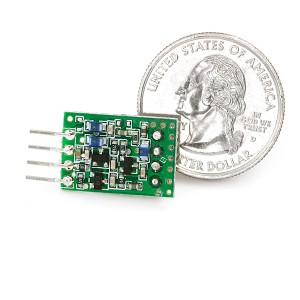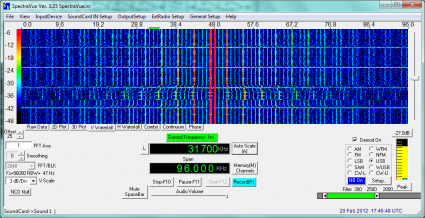Examining the output of a simple remote-keyless-entry transmitter…
 Yesterday I was looking (sadly unsuccessfully) for some BPW32 photodiodes that I know I have somewhere, when I ran across some of 434 Mhz transmitter modules from Sparkfun (now a retired part) that I had never used. These little $4 transmitters are commonly used for remote-keyless access or similar applications. They have just four pins: power, ground, a data pin, and an antenna, so they are easy to interface. I thought that they might be useful as backup low power beacon transmitter aboard a high altitude balloon payload, but I had never unpacked them, never tried them out. It dawned on me that I might also be able to use them with my code which I had previously written to send Hellschrieber telemetry. But to start out, I just made a simple program that sent the string “BEACON” at 1 second intervals and fed it to the data pin.
Yesterday I was looking (sadly unsuccessfully) for some BPW32 photodiodes that I know I have somewhere, when I ran across some of 434 Mhz transmitter modules from Sparkfun (now a retired part) that I had never used. These little $4 transmitters are commonly used for remote-keyless access or similar applications. They have just four pins: power, ground, a data pin, and an antenna, so they are easy to interface. I thought that they might be useful as backup low power beacon transmitter aboard a high altitude balloon payload, but I had never unpacked them, never tried them out. It dawned on me that I might also be able to use them with my code which I had previously written to send Hellschrieber telemetry. But to start out, I just made a simple program that sent the string “BEACON” at 1 second intervals and fed it to the data pin.
But how to receive it? I fired up my FT-817 and tuned it roughly to 433.920 Mhz (the nominal frequency) and even without an antenna, I could clearly hear the buzzy signal with a 1 second period. In fact, I could still hear it over 50Khz away from the nominal frequency. The signal was very, very wide. That got me curious so I dug out my Funcube Dongle Pro, hooked up a simple wire whip antenna, and tuned it in.
Here’s a picture of 96Khz surrounding 433.920:
Bleh. Really wide, really ugly, and really unpleasant sounding in the earphone. The horizontal lines coincide with the transmissions, the long harmonic laden regions in between are the “dead times”.
I suppose that if you were only using these intermittently in a key fob kind of situation, I could justify using something like this, but for the kind of application I was envisioning, they just seem gratuitously poor. Still, it was fun getting my Funcube Dongle out of the box and playing with it again.
Addendum: they also don’t work as a Hellschrieber transmitter. I hooked up my “Hellduino” code, but the resulting spray of noise didn’t provide any useful decodes. I think that the transmitter has an upper limit on how long pulses can be, and is also sending AM modulated signals, rather that keyed CW.

I recall burning three or four weeks of a sabbatical getting Saccade.com on the air with Wordpress. So much tweaking…